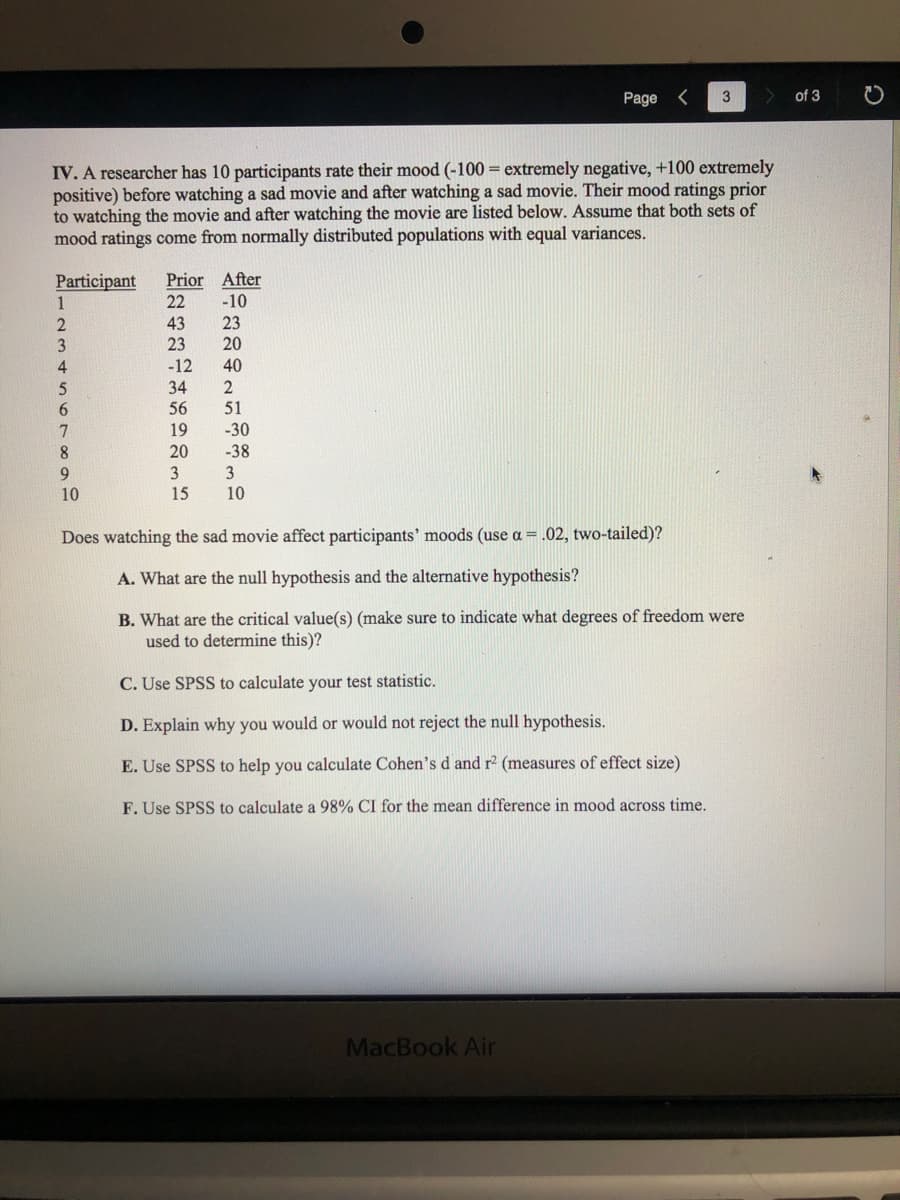IV. A researcher has 10 participants rate their mood (-100 = extremely negative, +100 extremely positive) before watching a sad movie and after watching a sad movie. Their mood ratings prior to watching the movie and after watching the movie are listed below. Assume that both sets of mood ratings come from normally distributed populations with equal variances. Prior After 22 Participant 1 -10 23 20 43 23 -12 34 4 40 56 19 51 -30 -38 3 20 8. 9. 10 15 10 Does watching the sad movie affect participants' moods (use a = .02, two-tailed)? A. What are the null hypothesis and the alternative hypothesis? B. What are the critical value(s) (make sure to indicate what degrees of freedom were used to determine this)? C. Use SPSS to calculate your test statistic. D. Explain why you would or would not reject the null hypothesis. E. Use SPSS to help you calculate Cohen's d and r (measures of effect size) F. Use SPSS to calculate a 98% CI for the mean difference in mood across time.
IV. A researcher has 10 participants rate their mood (-100 = extremely negative, +100 extremely positive) before watching a sad movie and after watching a sad movie. Their mood ratings prior to watching the movie and after watching the movie are listed below. Assume that both sets of mood ratings come from normally distributed populations with equal variances. Prior After 22 Participant 1 -10 23 20 43 23 -12 34 4 40 56 19 51 -30 -38 3 20 8. 9. 10 15 10 Does watching the sad movie affect participants' moods (use a = .02, two-tailed)? A. What are the null hypothesis and the alternative hypothesis? B. What are the critical value(s) (make sure to indicate what degrees of freedom were used to determine this)? C. Use SPSS to calculate your test statistic. D. Explain why you would or would not reject the null hypothesis. E. Use SPSS to help you calculate Cohen's d and r (measures of effect size) F. Use SPSS to calculate a 98% CI for the mean difference in mood across time.
College Algebra (MindTap Course List)
12th Edition
ISBN:9781305652231
Author:R. David Gustafson, Jeff Hughes
Publisher:R. David Gustafson, Jeff Hughes
Chapter8: Sequences, Series, And Probability
Section8.7: Probability
Problem 58E: What is meant by the sample space of an experiment?
Related questions
Topic Video
Question

Transcribed Image Text:Page
of 3
IV. A researcher has 10 participants rate their mood (-100 = extremely negative, +100 extremely
positive) before watching a sad movie and after watching a sad movie. Their mood ratings prior
to watching the movie and after watching the movie are listed below. Assume that both sets of
mood ratings come from normally distributed populations with equal variances.
Participant
1
Prior After
-10
22
43
23
23
3
20
-12
40
34
6.
56
51
19
-30
-38
7
8.
20
3
10
15
10
Does watching the sad movie affect participants' moods (use a = .02, two-tailed)?
A. What are the null hypothesis and the alternative hypothesis?
B. What are the critical value(s) (make sure to indicate what degrees of freedom were
used to determine this)?
C. Use SPSS to calculate your test statistic.
D. Explain why you would or would not reject the null hypothesis.
E. Use SPSS to help you calculate Cohen's d and r2 (measures of effect size)
F. Use SPSS to calculate a 98% CI for the mean difference in mood across time.
MacBook Air
Expert Solution
This question has been solved!
Explore an expertly crafted, step-by-step solution for a thorough understanding of key concepts.
Step by step
Solved in 3 steps with 1 images

Knowledge Booster
Learn more about
Need a deep-dive on the concept behind this application? Look no further. Learn more about this topic, statistics and related others by exploring similar questions and additional content below.Recommended textbooks for you

College Algebra (MindTap Course List)
Algebra
ISBN:
9781305652231
Author:
R. David Gustafson, Jeff Hughes
Publisher:
Cengage Learning

College Algebra (MindTap Course List)
Algebra
ISBN:
9781305652231
Author:
R. David Gustafson, Jeff Hughes
Publisher:
Cengage Learning